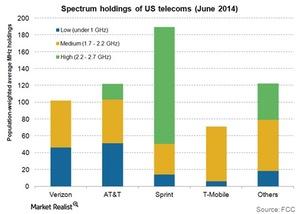Why spectrum is the lifeblood of a wireless network
We mentioned how wireless phones communicate with cell towers on a frequency band. The band is called a spectrum. It’s the most valuable resource for a wireless company.
Nov. 20 2020, Updated 10:54 a.m. ET

Spectrum
In the last part of this series, we mentioned how wireless phones communicate with cell towers on a frequency band. The band is called a spectrum. It’s the most valuable resource for a wireless company. Since spectrums are a finite resource, they’re allocated by the government.
Recently, the FCC (Federal Communications Commission) managed the AWS-3 spectrum auction. We discussed this in Verizon and AT&T are interested in the AWS-3 spectrum auction.
Key characteristics
Spectrums are defined by frequencies. Frequencies are measured in gigahertz, or GHz. The quality of wireless signals is affected by these frequencies. Low-frequency spectrums let wireless signals travel long distances. As a result, they provide excellent network coverage even in rural areas. They provide better in-building penetration in urban areas.
High-frequency spectrums make wireless signals travel shorter distances. They carry significant amounts of data. This helps telecom companies cope with increasing network traffic. Therefore, spectrums with frequencies less than 1 GHz are often called coverage spectrums. Spectrums with frequencies above 1 GHz are called capacity spectrums.
Apart from the propagation qualities, the costs associated with spectrums of different frequencies also vary. In coverage spectrums, telecom companies require fewer cell towers to set up the network than in higher frequency capacity spectrums. So, the cost of setting up a network in a coverage spectrum is lower than in capacity spectrums.
US telecom companies’ holdings
In the US, spectrums can be divided into three bands—low, medium, and high frequency. As you can see in the above graph, Sprint (S) has the largest spectrum holding—particularly in the high-frequency capacity spectrum. It’s followed by the other national carriers—AT&T (T), Verizon (VZ), and T-Mobile (TMUS). Among the regional carriers, U.S. Cellular (USM) has a significant spectrum holding.
In the low-frequency coverage spectrum Verizon and AT&T dominate the market. They have collective market shares of 73%. Combined, Sprint and T-Mobile hold a 15% share. This spectrum is critical for network coverage in urban and rural areas. In the US, Verizon and AT&T’s land coverage is 52% and 48% in 4G services. As of June 2014, Sprint and T-Mobile’s land coverage was only 12% and 9%.
